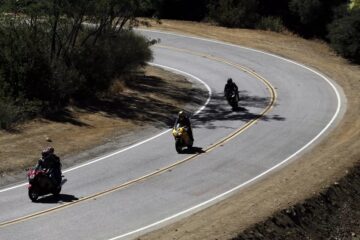And along came a rider
When humans and horses collide, problems can arise
Source of this article: The Thousand Oaks Acorn, July 10, 2014
Gorgeous weather and longer days bring outdoor enthusiasts in greater numbers to the city’s many trails, streets and pathways. Skateboarders, bicyclists, hikers, dog walkers and horseback riders alike all have to share the trails, but not everyone is aware of how to do so safely.
Aubree Conklin of Thousand Oaks was walking her mare to the Conejo Creek Equestrian Park recently when a passerby gave both her and her steed a surprise.
“A skateboarder thought it would be really fun to slap my horse on the butt. It didn’t go well,” Conklin said. “(The horse) flipped out. She spun around . . . and then stood there staring at him, wondering if he was going to do it again.”

NOT SUCH A STRANGE SIGHT—It’s not totally uncommon for drivers to encounter riders on horseback at some locations in Thousand Oaks and Newbury Park. Here, Aubree Conklin and Natalie Hill ride along the bridge over the 23 Freeway on Avenida de Las Flores.
A member of the local Equestrian Trails Inc. chapter and Conejo Riders Drill Team, Conklin said people whose main exposure to horses are at parades and other public events often don’t realize those animals have been extremely welltrained, “or bomb proofed, if you will,” but many horses haven’t had the same type of sensitivity training to loud noises, sudden movements, little children and other things that could spook them.
To that end, she said, practicing a little courtesy and common sense can avoid harm to the horse, rider and third parties.
Conklin said one of the main things to keep in mind is speed. Whether someone’s in a car or on a bike or skateboard, they should slow down and give the horse space, she said.
“It’s a 1,500-pound animal. If you were to collide, you wouldn’t be happy, the horse wouldn’t be happy. There’s no situation where it’s a win-win,” she said.
Christine McQuaid, vice presi- dent and activity chair for ETI Corral 37—a nonprofit dedicated to equine legislation, acquisition and preservation of riding and hiking trails—said she’s been mere inches from being hit by a car while she was riding on the street preparing to make a left turn after signaling.
“A driver sped around me and almost hit me,” she said. “I don’t know if drivers know the right of way for horses, but they should basically treat them like they would a pedestrian.”
Small children and off-leash dogs can also be a problem for horses and their riders. Dog owners who take their pets to the dog park next to the equestrian center sometimes forget to put leashes back on their dogs when they’re done at the park and, on occasion, the dogs wander over to the horse area, which can scare the horses, Conklin said.
Sudden movements by children can do so as well.
“I know it’s really fun for children to run up and say hi to the pony or pet the pony or hug the pony. It’s cute,” Conklin said, “but kids have really small feet and it’s easy to get stepped on.”
She said most horse owners are happy to let children pet their horses, but the youngsters or their parents should ask before approaching. That allows the rider to remind them to approach slowly and speak gently. Or riders can explain that the particular horse doesn’t like strangers to approach.
“Horses are like dogs,” said Matt Kouba, Conejo Recreation and Park District superintendent. “Each one’s got its own personality and its own comfort zone.”
He said the district is proud of its multi-use trails that hikers, bikers and equestrians all share. He said a trail advisory committee made up of all three has helped to get everyone to share the trails and “play well together.”
Kouba said on trails, horses have the right of way.
“Everyone should yield to a horse. If you’re on a bike and a horse should be coming toward you, you should stop until the rider tells you to go ahead. That goes for hikers, too,” he said.
If bicyclists or others are coming up behind a horse, McQuaid said, calling out to the rider will help the equestrian to prepare to let them pass.
“The horses will always know they’re there before the rider, so they’re more apt to spook,” she said. “But if you say, ‘Hey, coming behind you,’ the rider can turn the horse so it can see the bicyclist” and be less likely to spook.
McQuaid said riders themselves also should extend courtesies, both to other riders as well as non-riders.
“If I’m heading up a steep trail with lots of switchbacks and a mountain biker is coming down, I always yell, ‘Horse ahead of you!’” she said, explaining it gives bicyclists the opportunity to start to slow down early.
Often, riders will carry bells or other things that make noise so others can hear them coming.
McQuaid said riders who are on open trails where they can canter or gallop should slow down when they approach others. This is important etiquette for horse-to-horse interaction as well as for hikers and others.
“If you gallop up behind another horse, they could go into fight-or-flight mode, especially flight because it thinks the other horse is running from something threatening and it should run, too,” she said.
In her 15 years riding in T.O., McQuaid said safety has been an ongoing problem, but what it comes down to is simple.
“I would think common courtesy is always the bottom line,” she said.



0 Comments